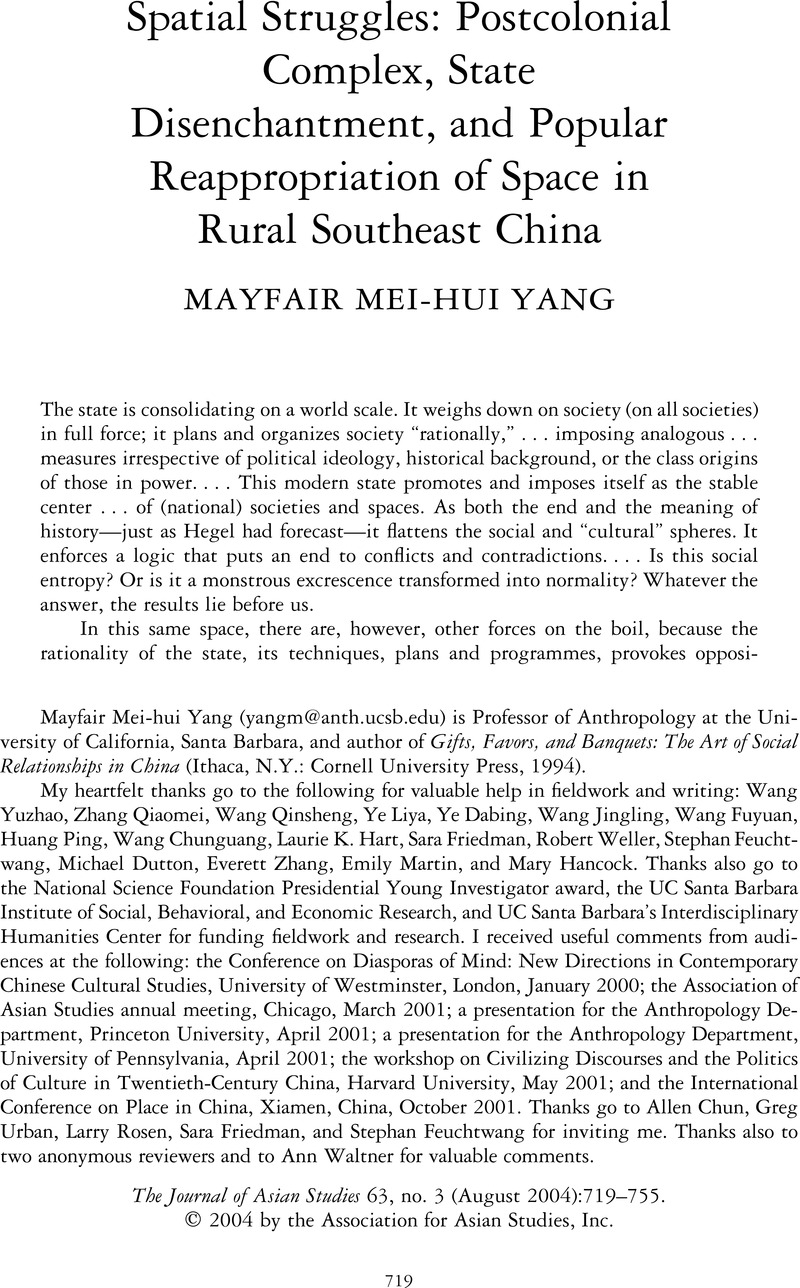Crossref Citations
This article has been cited by the following publications. This list is generated based on data provided by Crossref.
Ashiwa, Yoshiko
and
Wank, David L.
2006.
The Politics of a Reviving Buddhist Temple: State, Association, and Religion in Southeast China.
The Journal of Asian Studies,
Vol. 65,
Issue. 2,
p.
337.
Yang, Guobin
and
Calhoun, Craig
2007.
Media, Civil Society, and the Rise of a Green Public Sphere in China.
China Information,
Vol. 21,
Issue. 2,
p.
211.
SIU, HELEN F.
2007.
Grounding displacement: Uncivil urban spaces in postreform South China.
American Ethnologist,
Vol. 34,
Issue. 2,
p.
329.
Goossaert, Vincent
and
Ling, Fang
2008.
Les réformes funéraires et la politique religieuse de l’État chinois, 1900-2008.
Archives de sciences sociales des religions,
Vol. 144,
Issue. ,
p.
51.
Fisher, Gareth
2008.
The Spiritual Land Rush: Merit and Morality in New Chinese Buddhist Temple Construction.
The Journal of Asian Studies,
Vol. 67,
Issue. 1,
p.
143.
Perera, Nihal
2009.
People's Spaces: Familiarization, Subject Formation and Emergent Spaces in Colombo.
Planning Theory,
Vol. 8,
Issue. 1,
p.
51.
Xiaofei Kang
2009.
Two Temples, Three Religions, and a Tourist Attraction.
Modern China,
Vol. 35,
Issue. 3,
p.
227.
Dong Wang
2010.
Internationalizing heritage: UNESCO and China’s Longmen Grottoes.
China Information,
Vol. 24,
Issue. 2,
p.
123.
Yang, Mayfair Mei-hui
2011.
Postcoloniality and Religiosity in Modern China.
Theory, Culture & Society,
Vol. 28,
Issue. 2,
p.
3.
Abramson, Daniel Benjamin
2011.
Places for the Gods: Urban Planning as Orthopraxy and Heteropraxy in China.
Environment and Planning D: Society and Space,
Vol. 29,
Issue. 1,
p.
67.
Brandtstädter, Susanne
2011.
Kronglete moderniteter på den kinesiske landsbygda.
Norsk antropologisk tidsskrift,
Vol. 22,
Issue. 2,
p.
102.
Kong, Lily
2012.
No Place, New Places: Death and its Rituals in Urban Asia.
Urban Studies,
Vol. 49,
Issue. 2,
p.
415.
이응철
2012.
Memory, Oblivion, Identity and Placeness: Cultural Meanings of Huaihai Road, Shanghai, China.
Journal of Asia-Pacific Studies,
Vol. 19,
Issue. 2,
p.
41.
Trémon, Anne-Christine
2012.
Introduction : L’État au musée. Politiques muséales et patrimoniales dans le monde chinois contemporain.
Gradhiva,
p.
4.
이상빈
and
Myung-bae Yeom
2012.
The Historical Formation of the Industrial Cluster of Wenzhou in Zhejiang Province, China:Focusing on the Regional Culture and Entrepreneurship.
The Review of Business History,
Vol. 27,
Issue. 2,
p.
205.
Cao, Nanlai
2012.
Pentecostalism and Prosperity.
p.
151.
Wang, Jeff
Joy, Annamma
and
Sherry, John F.
2013.
Creating and sustaining a culture of hope: Feng Shui discourses and practices in Hong Kong.
Journal of Consumer Culture,
Vol. 13,
Issue. 3,
p.
241.
Brandtstädter, Susanne
2013.
Counterpolitics of Liberation in Contemporary China: Corruption, Law, and Popular Religion.
Ethnos,
Vol. 78,
Issue. 3,
p.
328.
Byrne, Denis
2013.
Love & loss in the 1960s.
International Journal of Heritage Studies,
Vol. 19,
Issue. 6,
p.
596.
Sun, Yanfei
2014.
Popular Religion in Zhejiang.
Modern China,
Vol. 40,
Issue. 5,
p.
455.



 .
. 